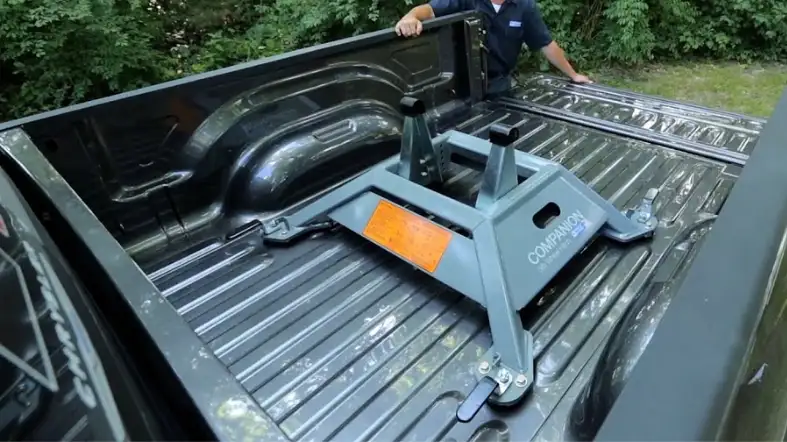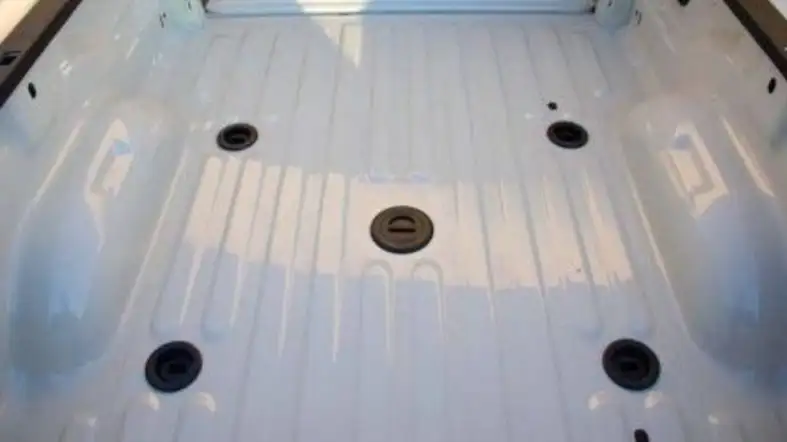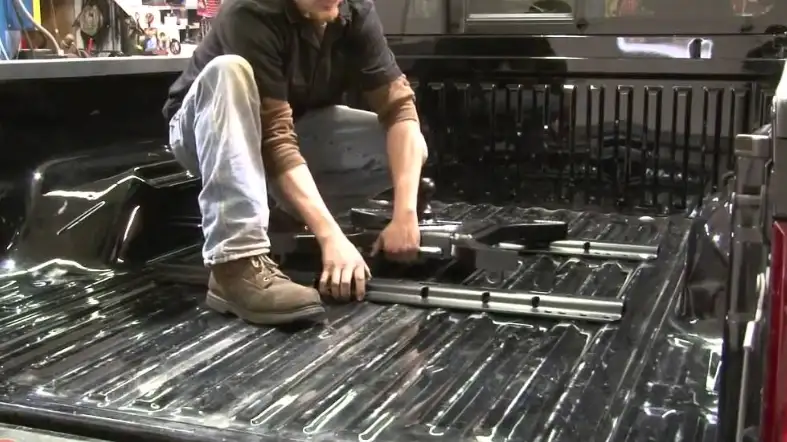Are you tired of constantly running out of propane while on the road in your truck?
Are you looking for a more efficient and convenient way to fuel your truck’s appliances?
Look no further than a puck system!
In this blog post, we will discuss the benefits of installing a puck system in a truck and the steps involved in the installation process.
Whether you’re a truck driver, a camper, or a van dweller, a puck system is a must-have for anyone who relies on propane to fuel their on-the-go lifestyle.

Can a puck system be installed in a truck?
Yes, a puck system can be installed in a truck.
A puck system is a type of cargo management system that can be mounted on the bed or cargo area of a truck to help organize and secure cargo.
It typically consists of a set of mounting plates or “pucks” that can be attached to the truck’s bed or cargo area, and additional accessories such as tie-downs or dividers that can be attached to the pucks.
Many puck systems are compatible with a wide range of truck makes and models and can be easily installed with the proper tools and materials.
how to Prepare for the Installation of A Puck System In A Truck?
Proper preparation for the installation of a puck system in a truck is crucial for a successful and efficient installation process.
By researching compatible systems, gathering necessary tools and materials, and preparing the truck, the installation process will go smoothly and the puck system will function at its best.

I. Researching Compatible Puck Systems
- Research different puck systems available on the market to find one that is compatible with the specific make and model of the truck.
- Consider factors such as compatibility with the truck’s electrical system, size and weight capacity, and additional features that may be useful.
- Check for any compatibility issues or limitations with the truck’s existing equipment or accessories.
II. Gathering Necessary Tools and Materials
- Make a list of all the tools and materials that will be needed for the installation process, such as drill bits, screws, wrenches, and electrical tape.
- Purchase or gather all necessary materials before beginning the installation process to ensure a smooth and efficient process.
- Double-check that all the necessary tools and materials are on hand before starting the installation.
III. Preparing the Truck for Installation
- Clean the truck’s bed or cargo area to ensure a clean surface for the puck system installation.
- Remove any existing equipment or accessories that may be in the way of the installation process.
- Check for any damage or wear and tear that may need to be addressed before installing the puck system.
- Make sure the truck is parked on a level surface for accurate alignment during the installation process.
How to install a puck system in a truck?
Installing a puck system in a truck can be a useful addition to help secure and transport items in the bed of the truck.
Puck systems consist of small, circular connectors that can be mounted to the bed of the truck and used to secure a variety of different items using straps or ropes.
Here, we will cover the steps on how to properly install a puck system in a truck to ensure a secure and safe transport for your belongings.
Tools and equipment needed:
drill, socket wrench or torque wrench, drill bit, puck anchors, puck plates, hardware or adhesive.
Steps:
1. Determine the location:
Firstly, determine the location for the puck system on the truck bed.
It is recommended to place it towards the front of the bed to allow for easier access and to avoid interference with the tailgate.
2. Measure and mark the location:
Measure and mark the pucks on the truck bed.
It is important to ensure that the pucks are evenly spaced and aligned with the truck’s load-bearing points.
3. Create holes:
Using a drill, create holes in the truck bed at the marked locations.
It is recommended to use a drill bit slightly smaller than the puck anchors to ensure a secure fit.
4. Install the puck:
Install the puck anchors into the holes.
This can be done using a socket wrench or a torque wrench to ensure proper torque.
5. Attach the puck:
Attach the puck plates onto the anchors.
This can be done using the provided hardware or adhesive.
6. Test the puck:
Test the puck system by placing a load onto the truck bed and checking to make sure the pucks are secure and holding the load in place.
Offer Tips Or Cautionary Advice For The Installation Process:

Installing a new system or component can be a daunting task, especially if you are not familiar with the process.
Here, we will offer tips and cautionary advice to help you navigate the installation process smoothly and safely.
1. Follow the manufacturer’s instructions carefully.
Do not skip steps or alter the installation process in any way.
2. Make sure you have all the necessary tools and equipment before beginning the installation process.
3. If you are not comfortable or familiar with the installation process, consider hiring a professional to handle the installation for you.
4. Take your time and double-check your work as you go.
An improperly installed product can be dangerous or cause damage to your home.
5. Wear protective gear, such as gloves, goggles, and earplugs, if necessary.
6. Turn off any electricity or gas in the area where you will be working to avoid any accidents.
7. Make sure you have enough ventilation in the area where you will be working, especially if you are using chemicals or power tools.
8. Keep children and pets away from the work area to prevent any accidents.
9. If you encounter any problems during the installation process, do not try to force or manipulate the product.
Contact the manufacturer or a professional for assistance.
Benefits Of Installing A Puck System In A Truck

There are several benefits to installing a puck system in a truck:
1. Improved fuel efficiency:
A puck system allows the truck to distribute weight more evenly, which can lead to improved fuel efficiency.
This is because the puck system evenly distributes the weight of the load across the truck’s axles, which reduces the strain on the engine and allows it to operate more efficiently.
2. Increased towing capacity:
Puck systems are designed to increase the towing capacity of a truck.
This is because the pucks are able to distribute the weight of the load more evenly, which allows the truck to safely tow more weight.
3. Enhanced stability:
Puck systems help to improve the stability of the truck when towing heavy loads.
This is because the pucks distribute the weight of the load more evenly, which helps to reduce the risk of the truck tipping over or losing control.
4. Greater safety:
Puck systems can also help to improve safety on the road by reducing the risk of accidents caused by uneven weight distribution or unstable loads.
5. Improved handling:
Puck systems can also help to improve the handling of the truck, making it easier to maneuver and control when towing heavy loads.
6. Enhanced durability:
Puck systems can also help to extend the life of a truck by reducing the strain on the engine and other components caused by uneven weight distribution.
This can help to reduce maintenance costs and extend the overall lifespan of the truck.
FAQs on installing a puck system in a truck
1. Are Puck Systems Safe To Use On My Truck?
Puck systems are designed to be safe and secure when used properly.
It is important to follow the manufacturer’s instructions and load limits for your puck system to ensure that it is used safely and correctly.
2. Can I Use A Puck System To Tow A Trailer With My Truck?
Yes, puck systems are designed specifically for towing trailers with trucks.
They provide a stable connection between the vehicle and the trailer, allowing for safe and smooth towing.
It is important to check the towing capacity of your truck and trailer before using a puck system to tow a trailer.
3. Can I Install A Puck System Myself?
Installing a puck system in a truck is typically a straightforward process, but it may require some mechanical skills and specialized tools.
If you are comfortable working on your own vehicle and have the necessary tools and knowledge, you may be able to install a puck system yourself.
However, if you are not confident in your abilities or do not have the required tools, it is recommended to have a professional mechanic or dealership handle the installation.
4. How Do I Know If My Truck Is Compatible With A Puck System?
To determine if your truck is compatible with a puck system, you will need to consult your truck’s owner’s manual or speak with a mechanic or dealership.
Some trucks may require modifications or additional brackets in order to install a puck system, so it’s important to research this before purchasing a puck system or attempting to install one yourself.
Conclusion:
In conclusion, it is possible to install a puck system in a truck.
However, it is important to keep in mind that it may require some modifications to the truck’s frame and suspension, as well as the proper tools and knowledge.
It is also important to ensure that the puck system is compatible with the specific make and model of the truck.
Overall, while it may be a bit of a challenge, installing a puck system in a truck can provide added stability and convenience for hauling heavy loads.
